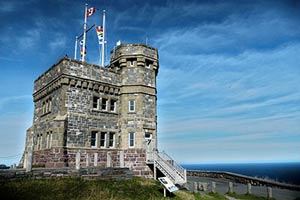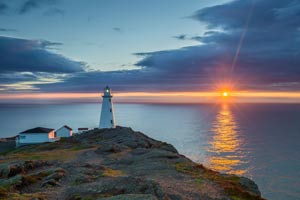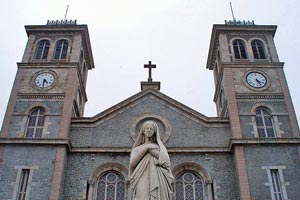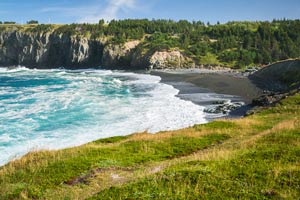
Take the hike to
Signal Hill. This was the site of St John`s harbour defence from the 17
th century to the Second World War and where a signalman, perched on the hill surveyed the ocean for ships headed toward the port and then communicated with the people in town with the help of flags. Here is where the first transatlantic wireless signal was received by Guglielmo Marconi. The signal was in Morse code and it was sent from Poldhu Wireless Station in Cornwall, UK. Today the site offers sweeping views of the city of St John`s and its harbour, as well as a very informative Visitors centre with a short presentation to take you through the story of Signal Hill.
 Enjoy the vistas from the easternmost point in North America – Cape Spear Lighthouse. Depending on the season, watch icebergs glide by, humpback whales splash about and pods of porpoises spin and jump in the deep-blue waters. The oldest lighthouse of Newfoundland and Labrador, built in 1836, is a prime example of the unique lighthouse architecture of those times. The lighthouse was a beacon of safe passage until 1955 when a new lighthouse tower was built nearby. Get a glimpse of the life of a lighthouse-keeper - the inside of the lighthouse residence is restored and offers an insight of the unique lifestyle of the Cantwells - the family that has been looking after the site for 150 years, from 1846 to 1997.
Enjoy the vistas from the easternmost point in North America – Cape Spear Lighthouse. Depending on the season, watch icebergs glide by, humpback whales splash about and pods of porpoises spin and jump in the deep-blue waters. The oldest lighthouse of Newfoundland and Labrador, built in 1836, is a prime example of the unique lighthouse architecture of those times. The lighthouse was a beacon of safe passage until 1955 when a new lighthouse tower was built nearby. Get a glimpse of the life of a lighthouse-keeper - the inside of the lighthouse residence is restored and offers an insight of the unique lifestyle of the Cantwells - the family that has been looking after the site for 150 years, from 1846 to 1997.
 The Rooms is the unusual name of Newfoundland and Labrador’s largest public cultural space. It represents and showcases the province to the world through its most extensive collection of artefacts, historical records and international, local, contemporary and folk art. The facility houses the Art Gallery, the Provincial Archives and the Provincial Museum of Newfoundland and Labrador. At The Rooms you can find permanent and temporary exhibitions and interactive activities that tell the story of the Province through art, artefacts, archaeology, architecture and archival records.
The Rooms is the unusual name of Newfoundland and Labrador’s largest public cultural space. It represents and showcases the province to the world through its most extensive collection of artefacts, historical records and international, local, contemporary and folk art. The facility houses the Art Gallery, the Provincial Archives and the Provincial Museum of Newfoundland and Labrador. At The Rooms you can find permanent and temporary exhibitions and interactive activities that tell the story of the Province through art, artefacts, archaeology, architecture and archival records.
The Johnson Geo Centre is a geological interpretation centre located at Signal Hill. Most of the building is underground, in an excavated glacial formation that shows the bedrock of the hill. The museum is named after philanthropist Paul Johnson who contributed with over half of the initial investment, needed for the facility. It exposes the uniqueness of the province, as no other easily accessible place on Earth has a geological record that fully reveals the history of the planet, going back almost to its birth, over 4.5 billion years ago.
 Go to Bannerman Park to fill your lungs with fresh air and admire the British parks design of 19th century. Go to the picturesque Quidi Vidi fishing village (pronounced Kiddy Viddy) and have a pint, produced at the largest microbrewery of Nefoundland – the Quidi Vidi Brewing Company. Or grab a quirky art piece from a local artist at Quidi Vidi Village Plantation. Attend a service or just snap some photos of the beautiful historic churche of St John`s – the Basilica Cathedral of St John the Baptist – built in 1855 it was the largest building project of its time in North America.
Go to Bannerman Park to fill your lungs with fresh air and admire the British parks design of 19th century. Go to the picturesque Quidi Vidi fishing village (pronounced Kiddy Viddy) and have a pint, produced at the largest microbrewery of Nefoundland – the Quidi Vidi Brewing Company. Or grab a quirky art piece from a local artist at Quidi Vidi Village Plantation. Attend a service or just snap some photos of the beautiful historic churche of St John`s – the Basilica Cathedral of St John the Baptist – built in 1855 it was the largest building project of its time in North America.
If you are in St John’s for more than a day and you feel like venturing out – one of the points of interest outside of the city is the East Coast Trail – pick any section of this 540km (336miles) long trail, depending on your interest, time, and hiking abilities. There is so much to see and do there, that the path was named the best adventure destination by National Geographic in 2012 and it has kept improving since.